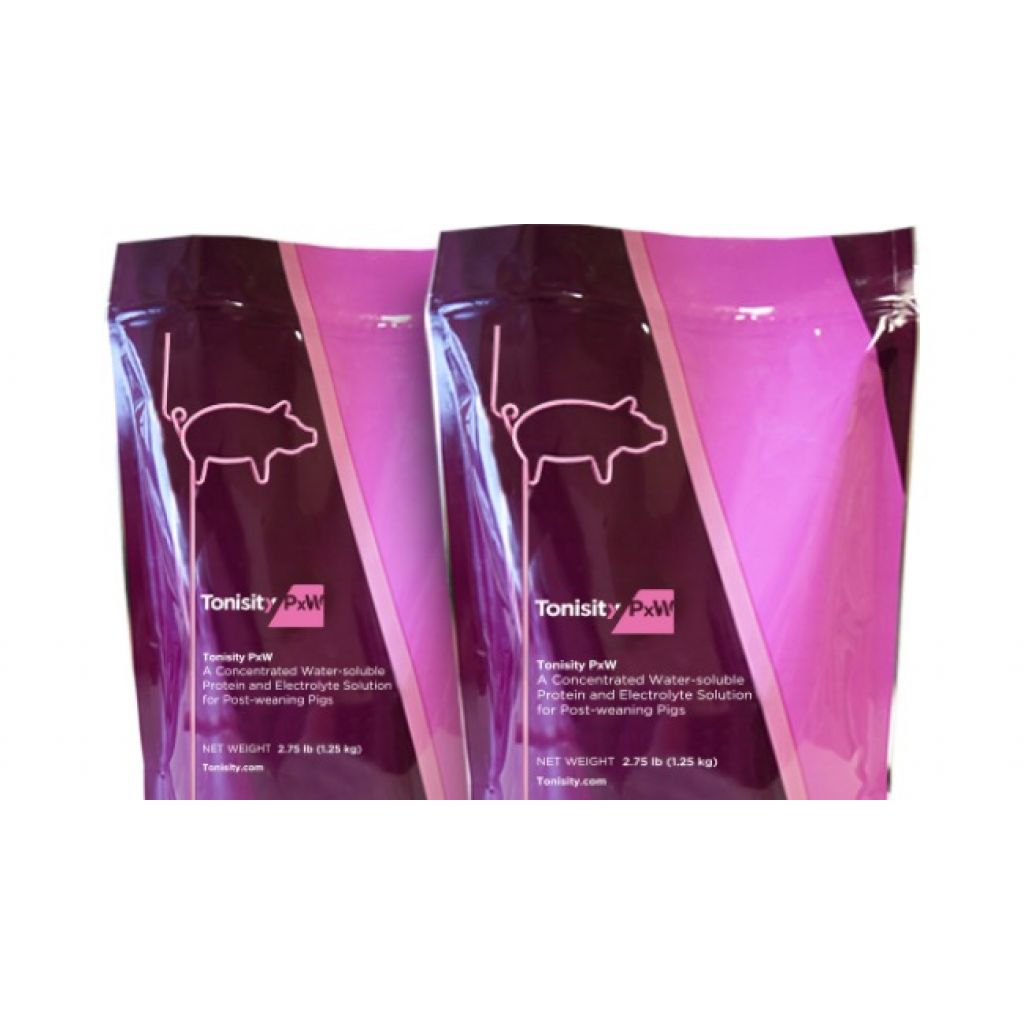The Importance of Early Feeding for Piglets Before and During Weaning
Weaning is a highly stressful period for piglets, marked by significant dietary changes and separation from the sow. A thesis from Choudhury (2021) emphasises the fact that after weaning, piglets must abruptly adjust from their mother’s milk to less digestible, plant-based solid diet rich in complex proteins and carbohydrates. This sudden dietary change often results in a significant drop in feed intake immediately after weaning, with some piglets not consuming feed for up to 48 hours. The lack of nutrients due to reduced feed intake can cause intestinal issues, leading to a temporary "growth check" in the first 7 to 10 days post-weaning. Additionally, the combined environmental, nutritional and psychological stressors make weaning a period with a high incidence of diarrhea.
Weaning stress has a significant impact on the intestinal function of piglets. Following weaning, their still-developing intestines experience changes in morphology, reduced digestive capabilities and disrupted balance between cell death and proliferation, leading to a reduction in intestinal villi size. Additionally, weaning stress negatively impacts the intestinal barrier, with proven damage to the tight junctions in the intestinal epithelial cells. These combined stresses compromise overall intestinal health and function, making the transition period particularly challenging for piglets (Tang et al., 2022).
Weaning of piglets usually happens around 3 to 4 weeks of age, but as rightly stated by Javier Lorente, “Weaning well starts before weaning" (Lorente, 2022). One of the keys for a successful weaning is early feeding, which is critical for piglets before and during weaning, as it plays a pivotal role in their growth, health, and overall performance. This practice involves introducing creep feed, a highly digestible and palatable diet, to piglets while they are still nursing. The benefits of early feeding are multifaceted, impacting digestive enzyme development, gut health and the weaning transition process.
Providing creep feed in small, frequently refreshed quantities starting as early as 3 to 7 days of age is essential. This practice encourages intake and helps piglets transition to solid feed at weaning. Using a highly palatable, complex diet that includes milk products can further enhance their feed consumption.
Typically, piglets consume between 400 to 600 g of creep feed when weaned at 26 to 28 days old. However, this amount can significantly differ depending on the farm and the specific litter. Piglets weaned at 21 days tend to consume considerably less, whereas those weaned at a later stage tend to eat more.
Positive impacts of an early feed intake
Easier weaning transition
Providing creep feed before weaning helps mitigate this stress by familiarising piglets with solid feed, thus smoothing the transition. Early feeding reduces the incidence of post-weaning diarrhea and promotes better gut health, which are critical for maintaining growth rates and preventing health issues. Moreover, piglets accustomed to creep feed tend to have higher feed intake immediately after weaning, supporting a smoother transition and reducing the likelihood of growth setbacks.
Better digestive enzyme development
Early introduction of solid feed helps develop digestive enzymes necessary for breaking down complex carbohydrates and proteins and facilitate nutrient absorption, improving digestive health and preparing piglets for weaning (Muro et al., 2023). This means that, by consuming solid feed before weaning, piglets can accelerate the maturation of their digestive systems. Studies have shown that early feed intake promotes a more diverse range of digestive enzymes, which are crucial for efficient nutrient absorption and overall digestive health. This enzymatic development helps piglets better manage the dietary transition at weaning, reducing the risk of digestive disturbances.
Improved microbiota and gut health
The introduction of creep feed also positively influences the gut microbiota of piglets. Early feeding promotes a more diverse and stable gut microbiome, which is essential for effective digestion and immune function. Research indicates that piglets receiving creep feed exhibit accelerated maturation of their gut microbiota, characterised by increased microbial diversity and the presence of beneficial microbial groups associated with post-weaning health (Choudhury and Kleerebezem, 2021). This enhanced gut microbiota contributes to better overall gut health and resilience against weaning-related stress.
As a consequence, encouraging piglets to consume creep feed can significantly enhance their growth performance both pre- and post-weaning. A systematic review and meta-analysis revealed that creep feeding increases piglet body weight at weaning and improves growth performance during the nursery phase. Piglets provided with creep feed for more than 14 days showed higher weaning weights compared to those not given creep feed or provided for shorter periods (Muro et al., 2023). This early introduction to solid feed helps piglets adapt better to the dietary changes that occur at weaning, reducing growth setbacks and improving overall productivity.
Practical tips for a successful feeding around weaning
To maximise the benefits of early feeding, it is essential to follow several strategies:
- Creep Feed Provision: Offer fresh creep feed in small, frequent portions to encourage exploration and consumption. Position the feeder near the sow to stimulate interest by mimicking the sow's feeding behaviour.
- Hygiene and Freshness: Ensure that feed is fresh and consumed promptly to prevent spoilage. Maintain a clean feeding environment to promote health.
- Gradual Transition: Introduce creep feed from the second week after birth to acclimate piglets to solid feed. Continue providing access to creep feed up until weaning to minimise dietary stress.
- Using Tonisity Px: Research has shown that using Tonisity Px as a top dressing on feed, especially before and after weaning, can encourage piglets to consume more feed while staying hydrated and receiving intestinal support from the bioactive components present in the solution (Cortyl and Driscoll, 2023). Tonisity Px can also be used to encourage creep feed intake during the introduction phase. For instance, in one trial conducted in Spain in 2023, Tonisity Px litters consumed 98% (2.5x more than Controls) of the creep feed offered for the first three days (days 8 to 10 of life). Additionally, the use of Tonisity Px has been proven to enhance intestinal integrity, leading to taller intestinal villi (Barros Filho et al., 2019), and better tight junctions as well as enhanced immune function (Masiuk et al., 2024). This results in increased appetite and improved post-weaning performance, with benefits that last until the end of the fattening period (Cortyl et al., 2019). Starting piglets in better conditions results in heavier pigs at the end of the finishing phase, with faster growth rates and improved feed efficiency and a clear return on investment. It is common to observe that piglets given Tonisity Px during weaning reach their final weight 5 to 7 days earlier than those not receiving any treatment.
References
- Barros Filho, M. G.; Arruda, G. B. D.; Chaves, R. F.; Dantas, T. A.; Marques, A. S.; Firth, A.; Cantarelli, V. S. (2019). Utilização de um suplemento isotônico para leitões lactentes como preparação para o desmame. In: ABRAVES, 2019, Toledo. Anais do XIX Congresso Internacional ABRAVES, 2019.
- Choudhury, R. (2021) Early-life feeding in piglets: the impact on intestinal microbiota and mucosal development. Thesis, Graduate School of Wageningen Institute of Animal Sciences (WIAS).
- Choudhury, R. and Kleerebezem M. (2021). Why is early life feeding important in piglets? WIAS magazine - fall edition 2021. Article posted online: https://www.wur.nl/en/article/Why-is-early-life-feeding-important-in-piglets.htm
- Cortyl, M. and Driscoll, J. (2023). Effect of Tonisity Px gruel on feed intake and growth performance of piglets - Australian Pork Newspaper - November 2023: 11-14
- Cortyl, M.; Carlson, A.; Eisenhart, M.; Bretey, K.; Buzoianu, S.; Firth, A. (2019). Effect of supplemental nutrition through an isotonic protein solution provided days 2 to 8 of life on pre-weaning mortality of piglets and their lifetime performance. ASIAN PIG VETERINARY SOCIETY CONGRESS 2019, ORAL ABSTRACTS.
- Lorente, J. (2022). Weaning well starts "before weaning" - Everything you need to know to successfully wean your piglets. Article posted on Pig333 on 12/12/2022, https://www.pig333.com/articles/weaning-piglets-well-starts-before-weaning_18820/
- Masiuk, D. M.; Kokariev, A. V.; Buzoianu, S. G.; Firth, A. M.; Nedzvetsky, V. S. (2024). An isotonic protein solution favorably modulated the porcine intestinal immune response and cellular adhesion markers and reduced PEDV shedding in vivo. Vet Immunol Immunopathol 2024 May:271:110753. doi: 10.1016/j.vetimm.2024.110753.
- Muro, B.B.D.; Carnevale, R.F.; Monteiro, M.S.; Yao, R.; Ferreira, F.N.A.; Neta, C.S.S.; Pereira, F.A.; Maes, D.; Janssens, G.P.J.; Almond, G.W.; et al. (2023). A Systematic Review and Meta-Analysis of Creep Feeding Effects on Piglet Pre- and Post-Weaning Performance. Animals 2023, 13, 2156. https://doi.org/10.3390/ani13132156
- Tang X.: Xiong, K.; Fang R.; Li M. (2022) Weaning stress and intestinal health of piglets: A review. Front. Immunol. 13:1042778. doi: 10.3389/fimmu.2022.1042778
Demander un devis
Pour recevoir le devis, nous avons besoin que vous nous fournissiez les informations suivantes afin de calculer les frais d'expédition :




